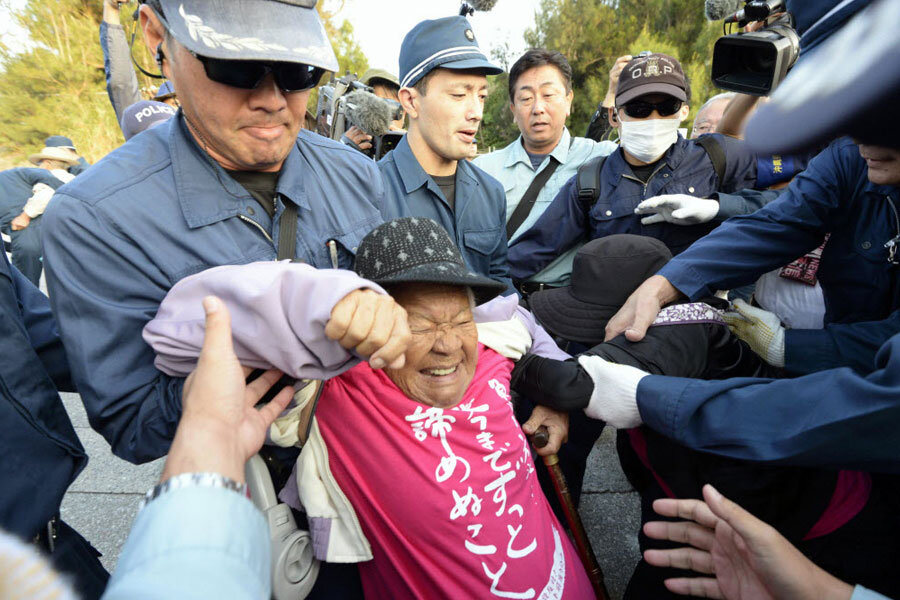In Japan's Okinawa, impasse over US air base fuels deepening tensions
| Tokyo
The US military presence on the small Japanese island of Okinawa is in as much doubt now as it has been in nearly two decades, as local residents step up their confrontation with the central government over the relocation of a US air base.
In 1996, following the rape of a schoolgirl in Okinawa by three US soldiers, the US military agreed to move Futenma, a sprawling Marine Corps base in the crowded city of Ginowan, to a sparsely populated coastal location. Washington also agreed to send 8,000 marines and their families to Guam and other locations. The burden on local people would ease, so the logic went, while Okinawa would retain its vital role for US forces in the western Pacific.
But the legal tug-of-war now being played out in Okinawa has jeopardized the move and officials in Washington are concerned that Japan may not be able to fulfill its side of the deal by the 2022 deadline. Many fear that failure to build the new $8.6 billion base could complicate President Obama’s strategic pivot towards the Asia Pacific.
The White House has focused heavily on the region amid growing concerns over China’s territorial claims in the South China Sea and North Korea’s nuclear weapons program. US military officials have said that keeping logistical, air, and ground forces close together is critical to maintaining their deterrent effect and for responding to emergencies in the region.
Keen to be viewed in Washington as a strong military partner, Japan's Prime Minister Shinzo Abe is determined to deliver on the project – even if it means ignoring the views of most of Okinawa’s 1.3 million residents. Scuffles have broken out between protesters and police in recent weeks in a sign of mounting tensions.
Mike Mochizuki, an associate professor at George Washington University who studies Japanese politics, says that the base relocation is far from a done deal. “The key issue is the politics and the potential cost to the central government,” he says. “The more the protests intensify and broaden, the more chance the protesters stand of winning sympathy.”
Last week police dragged away elderly demonstrators as they attempted to block the arrival of construction vehicles at Camp Schwab, the planned relocation site.
“The situation will get uglier,” says Hideki Yoshikawa, a regular protester outside the camp. “Our human rights are constantly being violated. We are being discriminated against by Abe, and President Obama is a mere bystander.”
The Henoko plan
There is broad agreement that Futenma should close. Its association with noise pollution, crime and, in 2004, a serious, though non-fatal, helicopter crash, has made it an easy target for the island’s anti-base movement.
The sticking point is what should happen next on Okinawa, which hosts more than half of the 47,000 US troops in Japan and three-quarters of US bases in the country.
Washington and Tokyo want Futenma rebuilt as part of Camp Schwab in the coastal district of Henoko, complete with a new and highly controversial runway built out at sea.
But most Okinawans, including Gov. Takeshi Onaga, say Futenma should be closed and rebuilt off the island. The Henoko plan, they say, will threaten the safety of local residents and destroy the area’s diverse marine ecosystem.
The recent discovery of ancient pottery and stone tools near Henoko could further complicate the relocation. Additional marine surveys would be required at the site if the prefectural government designates it as an archaeological ruin, reports the Asahi Shimbun, one of Japan’s leading newspapers.
The US has signaled that Futenma will remain open if the Henoko project doesn’t go ahead. Prof. Mochizki says that would be an even worse outcome for both Abe and Okinawans.
“Abe wants to push this,” he says. “He is very concerned about China, and thinks that building the base is vital vis-à-vis deterrence. He believes that if it doesn’t get built, it will send entirely the wrong signal to China.
Gov. Onaga raised the stakes last month when he revoked permission for landfill work at the Henoko site, reversing his predecessor’s decision in 2013 to allow land reclamation to proceed.
The central government, however, simply ignored Onaga. Construction crews moved in again last week, sparking altercations between the police and protesters.
Abe is aware that the escalating unrest could cause his Futenma plans to unravel, says Yukie Yoshikawa, an East Asian Studies fellow at Johns Hopkins University.
“The Abe cabinet will continue pushing for the Henoko plan until there are casualties on the ground,” says Ms. Yoshikawa, a former Okinawa prefectural government official. “That would spark fierce protests demanding the closure of all US bases on Okinawa. Abe would have to stop there.”






